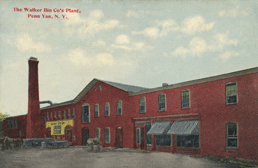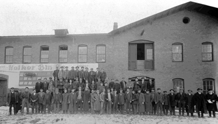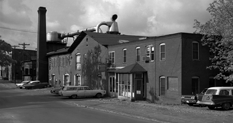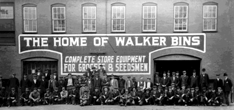|
Walkerbilt, Penn Yan, NY- Informational Manual
From an undated pamphlet produced by the Walkerbilt Company
History
 The industry known as Walkerbilt was originally established about 1870. At that time it was simply a saw mill and lumberyard. Soon a few woodworking machines were added to help the Company give milling service to the community. Gradually more machines were added and the production of factory fabrication used in building homes. Until factories made these items, they were made, as were all other wood products, by craftsmen on the premises as they built the buildings. They had to do it with hand tools so when factories started to make them with power tools quantity production proved superior. The industry known as Walkerbilt was originally established about 1870. At that time it was simply a saw mill and lumberyard. Soon a few woodworking machines were added to help the Company give milling service to the community. Gradually more machines were added and the production of factory fabrication used in building homes. Until factories made these items, they were made, as were all other wood products, by craftsmen on the premises as they built the buildings. They had to do it with hand tools so when factories started to make them with power tools quantity production proved superior.
About 1890, W.M. Patterson acquired the business and then further improved and strengthened it. About 1900, he became acquainted with E.J. Walker, a Philadelphia, Pa. Merchant. Mr. Walker was developing an idea for a special type of bin designed to be self-counterbalancing. In other words, by putting part of the bin overhanging in the front of its pivot, it was much easier to open and shut. Mr. Walker had started to build these bins in a factory in Camden, New Jersey. However, his acquaintance with Mr. Patterson developed into an arrangement to combine their resources. Mr. Walker had his Walker Patented Pivoted Bin Company. Mr. Patterson had his Planing Mill. The two were put together and operated in Penn Yan under the name of Walker Bin company.
This business flourished for 20-odd years and eventually had installations in thousands of stores all over the country and in several foreign countries. Penn Yan workmen even went as far as England making installations. The reason for their success was simple. Until this convenient bin built into counters and shelving came along, most foods, seeds, grains, and feeds had all been stored in barrels or bags. These were not clean and an invitation to vermin and infestation. The counterbalanced bin protected them and made dispensing easy. It was, in fact, suitable for use for anything that was handled in dry bulk.
Everything went fine with the Company until in the 1920’s package merchandise began to become popular. Stores that had used the bin system began changing over to newer methods because of consumer demand. Unfortunately, this loss of popularity was coupled with the Depression of the early 1930’s. As a result, new business to replace the dying fixture business was not readily available. Finally, in December 1933 the Walker Bin company closed.
 In March of 1934, four men revived the industry under the name of Walkerbilt because they believed that with care, it could be nursed back to health. The revival was successfully accomplished during the middle 1930’s. Woodwork for new central schools in Upstate New York was an important product during this period. About 1940, two of the original four in the new Company died and the business was carried on by survivors. In March of 1934, four men revived the industry under the name of Walkerbilt because they believed that with care, it could be nursed back to health. The revival was successfully accomplished during the middle 1930’s. Woodwork for new central schools in Upstate New York was an important product during this period. About 1940, two of the original four in the new Company died and the business was carried on by survivors.
Finally when World War II arrived, the Company was strong enough to take on production of many wooden products for war use. Its staff and facilities were greatly expanded and at the end of the war, it emerged with much greater strength, capacity and “know how”. These were turned promptly to the problem of reestablishment of civilian production. This was successfully accomplished as described in the next section.
PRESENT PRODUCTS, OPERATIONS & ORGANIZATION
Products
In general, Walkerbilt is both a building material dealer and woodwork manufacturer.
As a dealer, it buys and sells all of the construction materials used in homes, commercial buildings, farm buildings and other constructed units. These products include lumber, cement, windows, doors, roofing, paint, glass eavestrough, hardware, etc. The requirements for building are so diversified that the stocks carried have to include between ten and twelve thousand different items.
As a manufacturer, Walkerbilt engages in four different kinds of activity:
- Store fixtures: There still continues to be a demand for the old Walker Bin line of bins for use in seed stores. These fixtures have been streamlined, but they still use the basic idea of the self-counterbalancing bin. These units are used in conjunction with other store fixtures that have been designed for modern merchandising. The Company also makes fixtures for other retail businesses such as drug stores, shoe stores, dress shops, men’s furnishing stores, jewelry stores, etc. In other words, the Company designs and manufactures fixtures for almost any type of store.
- Industrial Wood Parts: Other manufacturers purchase from Walkerbilt parts for use in their products. One of the largest production items of this type is a table that is used on a tailor’s pressing machine to keep the clothes that are being pressed from falling to the floor around the machine and into the operating parts. These tables go to the manufacturer of the machine to be attached to it when the machine is delivered.
 Radio Cabinets: Stromberg-Carlson Company of Rochester, New York buys four of its models from Walkerbilt. the unassembled wood parts are made in the Lake Street Plant and then taken across town to the Champlin Avenue Assembly and Finishing Plant. There the cabinets are assembled and finished with stains, fillers and lacquers and the oil rubbed. After careful inspection, they are packed and trucked to Rochester. Radio Cabinets: Stromberg-Carlson Company of Rochester, New York buys four of its models from Walkerbilt. the unassembled wood parts are made in the Lake Street Plant and then taken across town to the Champlin Avenue Assembly and Finishing Plant. There the cabinets are assembled and finished with stains, fillers and lacquers and the oil rubbed. After careful inspection, they are packed and trucked to Rochester.- Custom Woodwork: Many different special wood items for individual customers are designed and made. These items range all the way from a special window to a haypress head block and to a special Mahogany bookcase. These items are known as custom woodwork and usually undertaken either in single unit orders or in very small quantities, to meet the needs of the individual customer.
Operations
In order to do the things that are described in the products section above, a considerable physical plant has been assembled. On Lake Street is a large warehouse with display area and offices for the operation of the Building Material Division. In this warehouse are kept some of the multitude of smaller items that have to be available.
On Commercial Avenue, which is across the street, are six large sheds and four acres of land that are used for the storage of lumber, shingles, tile, cement, brick and other heavy things that are not effected by unheated storage or in the case of outdoor storage, by some moisture from rain. In fact the open storage is required for drying recently cut lumber by exposure to wind and sun. Materials from this storage are delivered to customers or brought to the factory by a fleet of six trucks, a trailer and three wagons.
In addition to the Lake Street Warehouse, there are four manufacturing buildings. One of these is a small, one story dry kiln for the final curing of air dried lumber before it is used for manufacture. The other three are large, three story factories containing over 200 different woodworking machines. These machines include several different kinds of saws, machines for smoothing, planing, molding, shaping, mortiseing and tennoning lumber, Turning Lathes, both manual and automatic: Glue Presses: Sanding Machines: Assembly Clamps and finally equipment for finishing with stains, fillers, lacquers, varnishes and enamels. In short there are machines to do practically any known woodworking operation.
 At the Main Street end of the main are the offices. This includes on the ground floor the general, clerical, administrative and executive offices. On the second floor is the factory office which contains the Drafting Room doing the drawing required to plan production of the many different products; the Cost Department and its routing and scheduling charts required to keep track of tings; and the Plant Manager’s and Superintendent’s offices. At the Main Street end of the main are the offices. This includes on the ground floor the general, clerical, administrative and executive offices. On the second floor is the factory office which contains the Drafting Room doing the drawing required to plan production of the many different products; the Cost Department and its routing and scheduling charts required to keep track of tings; and the Plant Manager’s and Superintendent’s offices.
On Champlain Avenue is another factory building. This is a one story modern factory. In it are woodworking machines to facilitate the assembly of radio cabinets, clamps to hold them while they are being glued and screwed together, and spray booths and rubbing machines needed in the finishing processes. Of great importance are the final inspection lights and turn tables needed to permit a thorough look-over of every unit completed.
In summary the physical plant contains:
- Six working buildings, totaling 97,00 square feet of space of which all but 13,000 feet is protected by sprinkler system, containing 300 woodworking machines.
- Ten storage buildings containing 16,000 square feet of space.
- 3 ½ acres of open land storage.
Organization
The business is owned and managed by Welles Griffeth and John T. Andrews. Walkerbilt is their Partnership operating the Lake Street and Commercial Avenue Plant, warehouses and yard. Walkerbilt Cabinets, Inc, a Corporation, operates the Champlin Avenue Plant.
The Building Materials Division on Lake Street employs a Manager, a Foreman and 23 men, four of whom are in clerical positions.
The Lake Street Manufacturing Division employs a Manager, a Superintendent, 10 Foremen, 5 clerical men and women and 60 factory workers.
The Champlin Avenue Division employs a Manager, 2 Foremen, 43 men and 23 women.
The general office has four men and six women all in management and clerical positions.
In total the Company embraces a group totaling about 150 men and 30 women.
DISTRIBUTION OF PRODUCTS
- Building Materials Dealer Division – The diversified products sold at retail through this Division reach into every nook and cranny of Yates County. Since Walkerbilt has one of the most adequate stocks available to the residents of this County, they have quite naturally become accustomed to buying their buildings requirements there. Individual orders are sometimes taken by the purchaser but more frequently the Company makes delivery with one of its trucks direct to the job site. In addition to the materials that go into private hands in the County, much material is furnished to industries and commercial businesses for maintenance and expansion construction. The Company also sells in nearby cities where contractors and homeowners have learned of the large stocks carried and the service given
- Store fixtures – These units are sold countrywide. The Southern States and California are a particularly good market for the seed store fixtures. However, installations have been made in every state in the union. Other types of stores are usually sold nearer Penn Yan because the Company reputation is better known in the general store fixture field in the Northeast section of the country.
- Industrial Wood Parts – These products are sold to other manufacturers, mainly in Syracuse and Rochester and are then incorporated in machines that are shipped worldwide. All of our products are labeled with our name so the name is likely to turn up in almost any city anywhere. Returning GI's have mentioned seeing Walkerbilt Pressing Machine Tables in many out of the way places.
- General Special Order Millwork – This, like the building materials, is mainly sold near Penn Yan. Some of it may reach to far away places, perhaps because some summer resident has learned of the company’s products. However, most of it is produced for the convenience and use of our community.
- Stromberg-Carlson Radio Cabinets - As the name shows these cabinets are made and delivered to the Stromberg-Carlson Company in Rochester. There they are completed by the addition of the radio and phonograph and, in some cases, television units. Due to the nation wide distribution of Stromberg-Carlson, our cabinets find their way into private homes all over the country where, we hope, they add grace and charm to living.
THE FUTURE
It is hard to foretell the future. This however, we do know: Our Company’s position as a whole is strong in foundation, strong in reputation, strong in the “know how” of its staff.
For our building material business, we cannot help but be optimistic. We know that there is a tremendous backlog of building to be done. We believe that by offering the proper kind of materials in adequate stocks at fair prices, by offering courteous planning, advice and prompt and careful delivery, the Company will have the support of the building public.
Some of our manufactured products can be foreseen to have a steady and increasing demand.
Note: This article was most likely written in the early to mid 1950’s. The company was purchased by the Haywood Wakefield Company in 1974 and then sold to Pennsylvania House in 1979. Pennsylvania House eventually moved all operations out of Penn Yan. |
